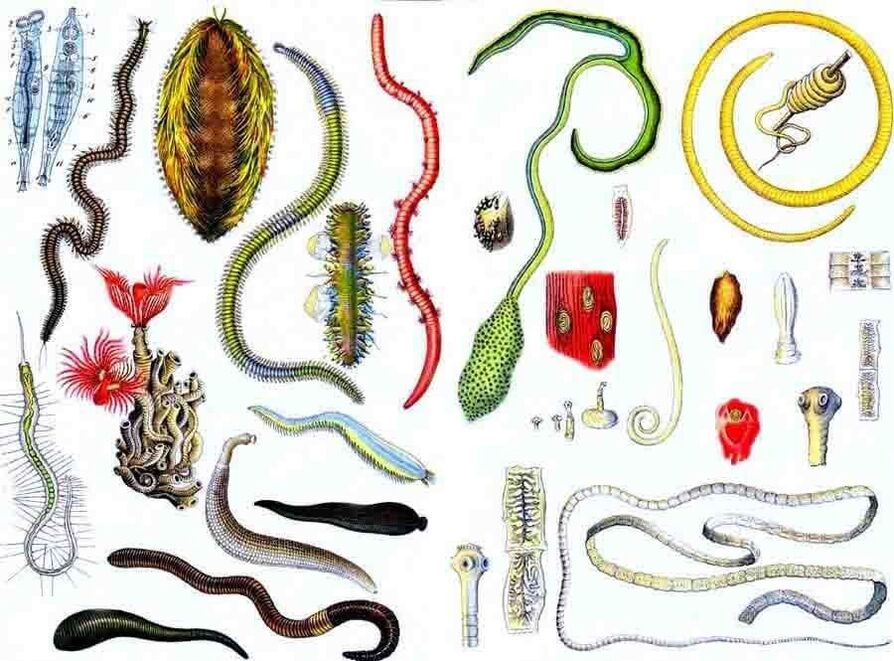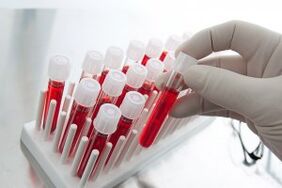Parasitic infection is called helminthiasis. This is a hidden danger and common disease, which may not have been realized for many years. Parasites enter the human intestines through dirty hands, food, and water and begin to reproduce actively.
They absorb nutrients, disrupt the absorption of water and vitamins in the intestine, causing diarrhea and the destruction of other internal organs. Therefore, it is important to know what tests need to be performed on the parasites in order to identify them in time and start the correct treatment.

Types of parasites and their diagnosis
Various types of worms can live in the human intestine: round, flat, and ribbon. Any parasite is dangerous to the human body because it releases toxic substances that affect internal organs.
The consequences of worm disease can be very different, including death.
Everyone should know what tests are needed for parasites. For preventive purposes and in the presence of characteristic symptoms, check. Do not postpone your visit to the doctor.
The danger in this situation is that the symptoms may not always appear. For a long time, a person may not know the existence of worms, but at the same time, a slow and irreversible process of destruction occurs in the organs. The route of infection is very different: contact with infected people or animals through dirty hands, soil, food, and water.
| Title | Path of infection | Symptoms | Analysis |
| Worms | Dirty hand pollution | Anal itching, diarrhea, weight loss | Anal swab |
| Scar insect disease | Eat unwashed vegetables and fruits | Weakness, itchy anus, poor bowel movements | Antibody blood test (ELISA) |
| Cat Fluke | Eat contaminated fish | Pain on the right side, allergic reaction, signs of liver damage | ELISA blood test |
| Trichinella | Eat contaminated meat and lard | Nausea, vomiting, diarrhea, skin allergic reaction, weakness | Anti-experience blood |
| Intestinal acne | Any contact with contaminated soil | Diarrhea, nausea, vomiting, abdominal pain | Research on worm eggs and stool, ELISA analysis |
The treatment of helminthiasis is individually selected. Before prescribing any medicine, your doctor will advise you to take a test and determine the exact type of parasite. Each parasite has a different effect on the body and causes different complications. In theory, they can affect any organ, but they are more common in the intestine. People at risk include children and people who work in the soil.

Main danger signs of parasitic infection
Identifying the infection can be tricky. Symptoms are not only affected by the type of worm, but also by the age of the infected person, the state of the immune system and other physical characteristics. The clinical manifestations are more acute due to the decreased immunity of children and the elderly.
Some chronic helminthiases have no obvious signs and acute manifestations. They last for years and go unnoticed because the symptoms are vague and easily confused with other chronic diseases.
When the following signs appear, immediately see a doctor and have a parasite check:
| Logo | Clinical manifestations |
| Increased body temperature | This symptom does not always occur, but if the internal organs are severely damaged, the temperature may rise, or even fever. |
| Stool disease | For helminthiasis, constipation and diarrhea can be observed. Various intestinal diseases will alternate with the passage of time, increasing or disappearing. In stool, impurities in mucus and blood are often found. |
| Nausea and vomiting | Symptoms of poisoning appear in the acute form of the disease. These symptoms can accompany any parasite infestation. |
| cough | As the course of the disease increases, worms can affect the bronchi and lungs. The patient developed a dry cough, which eventually turned into a wet cough. |
| Allergies | The immune system begins to react to the parasites, so allergic reactions occur, usually skin reactions: itching, redness, hives. |
| Chronic fatigue | Helminthiasis can cause weakness, fatigue, and lethargy due to body poisoning. |
| Weight loss | Due to poor intestinal absorption, people lose weight even if they eat the same diet. |
No matter what kind of worm has settled in the intestine, treatment should be started as soon as possible. Parasites can cause inflammation of the intestines, penetrating the lungs, gallbladder and even the heart. Preventive inspections will help avoid serious consequences and complications.
Prepare for blood and stool tests
The reliability of the results depends not only on the laboratory and equipment, but also on the preparation rules. Violating these rules will lead to erroneous results. The person may miss this disease.
First of all, it is worth remembering that to assess the condition, you need to choose a verified clinic, a reliable laboratory with certified experts. If the examination is performed by a doctor, he will warn you to prepare for work.
Preparations for stool analysis include the following:
- A few days before delivery, you need to stick to a light diet and avoid spicy, fried, fast food and foods that can cause flatulence. It is recommended to eat cereals, soups, and low-fat dairy products.
- If you cannot go to the bathroom, you should not have an enema or take laxatives.
- It is not recommended to eat foods that will color the feces: plums, tomatoes, beets, herbs.
- Before testing, you need to purchase a sterile container with a special spatula. It is printed on the day of the test. Matchboxes cannot be used to collect materials.
- The minimum amount of stool required for analysis is 15 g. If the amount is small, the analysis must be repeated.
- Collect materials carefully to prevent urine or menstrual flow into the stool.
- If the analysis shows the presence of worms, after completing the treatment process, all the above rules must be followed and the analysis should be performed again.
Donation preparation is usually standard. You need to go to the laboratory on an empty stomach and avoid fatty or spicy food the day before. Any medications you take should be discussed with your doctor, as this may affect the results of the parasite test. It is recommended to abstain from alcohol a week before donating blood. On the day of the blood collection and the day before the blood collection, you cannot participate in physiotherapy procedures and cannot have an ultrasound scan. Smoking can also affect results. It is recommended not to smoke at least one hour before the examination.

Blood test for parasites
Blood tests for parasites are one of the most useful methods for diagnosing helminthiasis. There are several types of blood tests. The doctor will prescribe one or more prescriptions based on the clinical situation and memories.
The advantage of blood testing over analyzing worms in feces is that eggs are not always found in feces, and you need to enter a certain period of worm reproduction. You can donate blood any time you are infected. Almost all laboratory analyses are carried out using special equipment and have nothing to do with human factors. ELISA allows you not only to determine the worm, but also the degree of infection.
The doctor is responsible for decoding the results. The most common is to perform 3 blood tests to determine the worms in the body:
| Method | Analysis function |
| ELISA | ELISA is the most useful and reliable in determining parasite infection. The test is based on the antigen-antibody relationship. The results indicate whether a certain antibody is present in the blood, which indicates the acute or chronic stage of the disease. Therefore, with parasitic diseases, IgG antibodies will appear in the blood. The result is very simple, positive or negative. However, it must be remembered that these antibodies appear both in chronic infections and in the recovery period. |
| PCR | Polymerase chain reaction can also enable you to reliably determine whether there are parasites in your body. However, not all types of worms are defined in this way, only protozoa. The severity of the disease and the number of worms cannot be determined in this way. |
| UAC | This is a simple and quick diagnosis method that allows you to get an overview of the overall function of the body. The level of eosinophils may suspect the presence of parasites, which will increase. With the invasion of worms, the level of eosinophils exceeds 20% of the remaining white blood cells. In this case, further inspection and determination of the type of parasite are required. |

Fecal parasite test
The common procedure is laboratory testing of stool. If helminthiasis is suspected, a prescription should be prescribed: stool disorders, sudden weight loss, weakness, nausea, etc. You can participate in the joint program in any laboratory (private or municipal laboratory).
The following indicators will be considered when decoding:
| Indicators | Decryption |
| Consistency and smell | The normal consistency is sticky, with no undigested debris. |
| Color | Usually, the color is yellow or brown. Or too dark, indicating that there is hidden blood. Light color of stool indicates liver damage. |
| Weight | The presence of blood or mucus in stool should be considered. |
| White blood cells | White blood cells are usually found in feces, but in small numbers. If there are a lot of them, it means that the intestines have begun to become inflamed. |
| Acidity | The pH of the feces of healthy people is 4. 8-5. 8. If the acidity increases, the absorption of fatty acids in the intestine will be impaired. |
| Bilirubin | There is no bilirubin in the stool of healthy people. Its presence indicates malnutrition, increased peristalsis, and rapid excretion of feces. |
| Stable protein | The content of this enzyme in feces is as high as 350 mg/day. An increase indicates anemia, and a decrease indicates gallbladder disease. |
Only a doctor can make a diagnosis based on such results. May need further testing. For the results to be reliable, you need to collect and store materials correctly. It is recommended to deliver it to the laboratory as soon as possible.
Curettage
The scrapping of intestinal biasis is also a useful diagnosis. Hand it over according to instructions or prevention. This is a painless process. Use a small spatula or cotton swab to remove some material from the anus. Swipe the stick a few times to get the material.
The scraping is very simple-the worm eggs do not exist or exist. The disease is curable, but if the result is positive, the patient is isolated to prevent further spread of the infection.

























